Text
Ugh I totally agree, slacktivists really get my goat with how smug they are for doing absolutely nothing. The whole slacktivist debacle to me is similar to how we refer to our Facebook friends as that, “friends”. It’s a sleight of hand and people are being tricked into thinking sharing a #kony2012 tag to your friends and badgering them to do the same has same impact as organising a protest and making your voice heard. I’m not sure exactly why people do this, perhaps it’s due to language like “friends”, “Like”, and “share” being used to pretend they are somehow equal as their real world counterparts. Take the below as an example: that isn’t a pipe, nor is it a painting of a pipe. It’s an array of pixels displayed on a screen which REPRESENTS the famous painting by Magritte.

We should be careful not to get wrapped up in bullshit.
The Slack Activist - Don’t cut them some slack!
SLACKTIVIST – probably the best word ever to have been created for the online vocabulary.
The term “slacktivist” roughly refers to a person who has the best intentions and suggestions towards supporting a cause or maintain a protest but does not take any physical action. The internet has bred the largest forum and community of slacktivists this world has probably seen but will more than likely continue to grow (Dewey 2014).
Previously, people would only hear about great tragedies on the news in their own homes, would feel remorse, and then move on with their lives knowing that whilst a tragedy there was nothing they could do at that very moment in time. Perhaps a few people would get off their butts and do something but this post does not refer to those people.
Nowadays, when people see or hear about a tragedy it is not only reported on the news but also on a million website and social media channels. So now these same people are hearing this news from multiple sources and being hammered by how guilty they should feel about this tragedy, but again these same people feel they can do nothing BUT now they have an opportunity to “appear” as if they are doing something via an online activist protest. So now they feel a little less guilt, joining a whole crowd of guilt-ridden people trying to feel better about themselves but not actually achieving anything.
Most commonly known representations of these “protests” are the hundreds of hashtag movements seen almost now on a weekly basis. #prayforparis is a perfect of example of where a tragedy sparked an online slacktivist support movement which had absolutely no power or influence. No arrests were made as a result, no families of those killed or injured received extra care of support from this hashtag community. It was simply a way for those on the other side of the world, living in peaceful happy homes to show their empathy for the situation (Garber 2015). #Bringbackourgirls was another great hashtag protest that failed to have any real impact or resolution with the majority of the 276 kidnapped Nigerian girls still missing despite even highly influential people such as Michelle Obama and popstar Rhianna jumping on this slactivist tag (France-Presse 2016).
This online artificial world we interact with it seems has confused people into believing that you can solves the world’s problems from your living rooms or offices when in reality the only way things will change is if people turn of their computers and get out there and make a real difference.
Dewey, C 2014, “#Bringbackourgirls, #Kony2012, and the complete, divisive history of ‘hashtag activism’”, The Washington Post, viewed 26 January 2018, <https://www.washingtonpost.com/news/the-intersect/wp/2014/05/08/bringbackourgirls-kony2012-and-the-complete-divisive-history-of-hashtag-activism/?utm_term=.d3e79be1603a>.
France-Presse, A 2016, “Hashtag fail? Two years after the first #BringBackOurGirls tweet not much has changed”, Public Radio International, viewed 26 January 2018, <https://www.pri.org/stories/2016-04-13/hashtag-fail-two-years-after-first-bringbackourgirls-tweet-not-much-has-changed>.
Garber, M 2015, “#PrayForParis: When Empathy Becomes a Meme”, The Atlantic, viewed 26 January 2018, < https://www.theatlantic.com/entertainment/archive/2015/11/pray-for-paris-empathy-facebook/416196/>.
Check out the video “ Your ‘Like’ Doesn’t Help Charities, It’s Just Slacktivism”
youtube
4 notes
·
View notes
Text
It doesn’t surprise me that Tony “destroyer of NBN” Abbott doesn’t understand that Twitter affords for much more than just rebroadcasting political points. I feel though that Twitter isn’t inherently more open or transparent as you put it; it is seen as open or transparent becuase that’s how people general use it. Social media can be mediated and opaque as anything, it’s just our perception.
Politics and social media
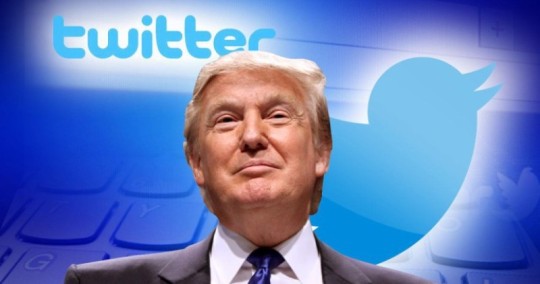
Social media is changing the way we are all communicating, including that of politicians and their constituents. In recent times, social media has become an important tool for politicians when campaigning. For example, both Donald Trump’s and Kevin Rudd’s used social media effectively to some degree during their recent election campaigns.
In Australian politics, if we look at the popularity of Kevin Rudd on social media versus Tony Abbott, you can understand why social media became such a powerful tool for Kevin Rudd during his election campaigns. Kevin Rudd has nearly 1.4 million followers on Twitter whereas Tony Abbott has just over 150,000 (The Sydney Morning Herald, 2013). Kevin Rudd tends to use a more personal tone on social media, whereas Tony Abbott’s profiles are more information-centric and more like he is broadcasting his messages to the community instead of using the platform to engage with them. During his 2007 campaign, Kevin Rudd utilised the use of a hashtag ‘#kevin07’, which appealed directly to the youth of Australia, and engaged them to be involved more heavily in politics than they had been in the past (Giulianotti 2002).
Donald Trump used Twitter throughout his 2016 Presidential Campaign to reach a wider-audience and share his views without going through traditional media channels. Social media has also changed the way many people receive their news. A study from the University of Canberra highlighted that 65 per cent of people follow politicians on social media because of “concerns about the accuracy and fairness of political [news] coverage” (The Guardian, 2017). This was obvious in terms of Donald Trump’s campaign with millions of Americans following him throughout the election process. Using social media at key times throughout his campaign, meant Trump constantly had the support of his followers and they ensured his name continued to be in the media by keeping his tweets trending (Larson 2016). This resulted in traditional media, such as newspaper coverage, being impacted by the results of Twitter and other social media platforms (Larson 2016).
Social media is constantly changing the way society works and connects with one another, and this is no different in terms of the relationship between politicians and their communities. Due to the openness and transparency of social media, it feels as though there is an even closer connection now between politicians and their followers.
Reference list
Giulianotti, R 2002, Supporters, followers, fans and flaneurs: A taxonomy of of spectator identities in football, Journal of Sport and Social Issues, February, vol 26 no. 1, pp 25-46, viewed 29 January 2017.
Larson, A 2016 Donald Trump’s Twitter and His Influence on the Media: A Study of How Political Social Media Accounts Impact Press Coverage, viewed on 25 January 2018. <http://www.com.washington.edu/wp-content/uploads/2017/06/Larson-Honors-Thesis-Final.pdf>
The Guardian, 2017 More Australians follow politicians on social media due to mainstream dissatisfaction report viewed on 1 January 2018 <https://www.theguardian.com/australia-news/2017/jun/22/more-australians-follow-politicians-on-social-media-due-to-mainstream-dissatisfaction-report>
The Sydney Morning Herald 2013, Social Media stakes: Rudd & Abbott, viewed 25 January 2018, <http://images.smh.com.au/file/2013/08/07/4640158/Web_ElectionSocial/>.
2 notes
·
View notes
Text
Week 9: How much are we sharing?
As bandwidth increases and the cameras on our phones get better, it is only natural that digital communities built around social-imaging grow and prosper. With more and more money being poured into UI/UX and 5G networks around the corner, sharing your photographs and videos has become so easy and normalised that it is considered strange if you don’t share at all.
From sharing Facebook photos of your kids first steps to masturbating for a special someone on Snapchat; 10 years ago, anyone would be shocked at the amount of information we share in public eye. But like a frog in a pot, I think we are constantly acclimatising to the increasing rate at which we share social visual content.
A fairly recent trend which like the rest of social media is growing and expanding is creating Facebook or other social media accounts for your new born kids and sharing photos on their behalf, often these profiles are shared in the open. Who is to say that in 15 years time that the profile will still be on the Facebook servers, accessible now to anyone who searches your daughter’s name. Creating a profile and posting personal details on behalf of your child removes their agency. With society heading into the information age, profiles are valuable commodities. In the future, this profile could be used to build a sort of digital fingerprint which could be used to identify them through a process called heuristics.
People joke about social media being the perfect tool for government agencies to accrue data on a person, but malicious entities are often just as competent as let’s say, ASIO. From birth, harmful actors could build a very complete profile of your son/daughter depending on how much you share: exact location at given times if you have GPS enabled on your photo uploads; if you post enough photos of their face you can build a 3d model of their head, and lots of other details.
For example, in 2012, Walmart came under fire when they were revealed to be tracking their customers; an angry father marched into a Minneapolis Walmart demanding to know why his daughter was being sent coupons for baby products. What the father didn’t know was his daughter was in fact pregnant, her digital fingerprint revealed a personal secret not even her family knew. Take into account how fast technology advances and we can barely imagine how effective this tracking is in 2018.
What right do we have as parents to create a digital copy of them which could be used to give advertisers, the government and potentially malicious actors the information to be used against them. Often, you are sharing much more than you realise.
Lubin, G. (2012). The incredible story of how Target exposed a teen girl's pregnancy. [online] Business Insider Australia. Available at: https://www.businessinsider.com.au/the-incredible-story-of-how-target-exposed-a-teen-girls-pregnancy-2012-2 [Accessed 5 Feb. 2018].
1 note
·
View note
Text
Week 10: World of Warcraft
World of Warcraft is an MMORPG with a focus on community. Blizzard Entertainment since World of Warcraft’s release in 2004 has made sure that the RPG part of MMORPG was not neglected for the (at the time of release) more exciting MMO (Massively multiplayer online) aspect. Blizzard ensured that when you choose a character in the game, you were restricted to speaking to only people from your faction. There are multiple ways to communicate with other players, one way is to simply press enter and when the chat window came up, if it said “Say”, you would cast your message about 25 meters. If an ally was in range they would get your message. If an enemy was in range, they would get a garbled message as the character they chose does not speak Orcish (for example).
In addition to the local chat feature, there is a ‘Global’ chat, in where your message would be cast to the entire faction, depending on the server you were playing on, this could be read by tens of thousands of players.
Blizzard, wanting to cater for and retain the more hard core RPG playerbase added a unique type of server (or Realm) which you could chose to create your character, the RP server which stands for Role Playing. On an RP server, not only do the normal chat rules apply, you must always speak in character. If you were a Troll, you had to speak like a Troll, otherwise you would be reported and possibly face a temporary or permanent ban from the server depending on how many infractions you accrued. You could prepend your message with OOC which stands for out of character, but being in in character was preferred. This all sounds fairly trivial but in 2006 something happened, a funeral was held on the Illidan realm for a real person who suffered a very real stroke. Times and locations were arranged on the WoW forums, and on the day a guild called ‘Serenity Now’ “raided” (which means to, in force, usually with a group, attack an opposing faction) the funeral and killed the attendees. People were in shock and completely outraged, how could this be allowed? Now the thing is, the Illidan server was a PvP server which means players are encouraged and rewarded for killing other players, there is no role playing enforced onto characters and ‘Serenity Now’ broke no rules, in fact they were rewarded with ‘honorable kills’ as the funeral location was in a special PvP location. Naturally there was a call to ban ‘Serenity Now’, but they had technically done nothing wrong. Watch the video below.
youtube
0 notes
Text
Week 11: The Great Firewall of China
The Internet is a globally distributed network. No one entity owns the Internet and thus it follows that no one can entity can decidedly govern online behaviour. For example, the Great Firewall of China blocks users from within the Chinese mainland accessing Wikipedia. Think of the Internet as a big map with lots of roads and ways to get to where you want to go. Going with analogy, China has checkpoints at every big intersection, a policeman walks up to you and asks where you are going, you reply “I’m going to this club called Youtube”, to which the policeman would reply, “Absolutely not, that club promotes things that PRC doesn’t want you to hear, I am going to write down your license plate and send you to Youku, be good now!”
Excellent, well now you’ve gotten to the club and it’s very popular, no surprise though since everyone has been made to go here. It’s full of people with a fairly similar life to yourself which is great, but there’s no real interesting conversation, there was someone who began to start talking about this thing called “democracy” but they were instantly booted from the club. But whatever, it’s comfortable here, you hear Youtube is better, but you’re comfortable here.
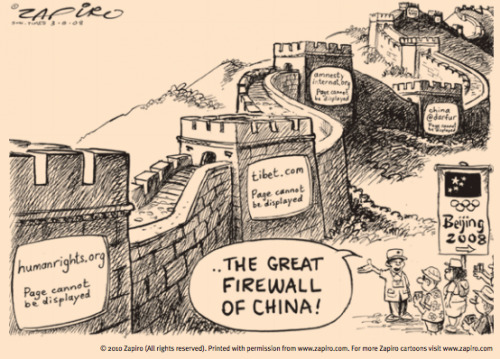
Years go by and Youku is expanding, it has more rooms than Youtube, bigger speakers, DJs that you want to see, local DJs are getting exposure and money, this is great. You hear that Youtube doesn’t have cameras in the bathrooms like Youku does. You’re embarrassed that the cameras at Youku see everything you would like to do in private. You’re a bit scared that the microphone may have heard you talk about DJ TIBET (who is inexplicably banned at any venue in China). Mostly though you’re always being watched and heard, you wanted to come to a club to unwind, talk to people with different opinions on things but you can’t, not only are you banned from talking about these things, you’re punished.
Breaking out of this analogy; it’s great that the Chinese now have a thriving digital community such as Youku but Cindy Chiu, Davis Lin and Ari Silverman are wrong (McKinsey, 2012) . China may be leading the way in terms of sheer amount of users, but they are severely lacking everywhere else. Sure, numbers are impressive, as I mentioned earlier, it helps local businesses, artists can connect and discuss their craft with more and more like minded people signing up every second. To me, this doesn't mean squat if you’re not allowed to discuss Tiananmen Square. When your country bans discussions about civil liberty you can never be “leading the way” (Chiu, Lin and Silverman, 2012) in any meaningful way.
Chiu, C., Lin, D. and Silverman, A. (2012). China’s social-media boom. [online] McKinsey & Company. Available at: https://www.mckinsey.com/business-functions/marketing-and-sales/our-insights/chinas-social-media-boom [Accessed 1 Feb. 2018].
0 notes
Text
Week 7: The internet hate machine
The infamous 4chan image board has been responsible for over a decade of trolling. 4chan’s /pol/ board has become the hub of online provocation recently. Originally /b/ or ‘Random’ was where “raids” and other trolling campaigns are formed, due to a surge of newer users, /pol/ is now this place.
You may have seen a green frog being associated with the alt-right movement. This cartoon frog Pepe began it’s life as the following meme in the mid 2000s:

And began to take on more forms, such as ‘Feels bad man’. Fast forward to the Clinton-Trump U.S. Presidential Election and 4chan, the self-proclaimed hate machine has ramped up production. Now 4chan’s version of Pepe are catching the attention of the entire world, and they loved it. You need to understand that 4chan are the biggest group of manchildren on the internet and nothing gives them more satisfaction than causing distress (just look up the 4chan raids on Habbo Hotel). Pepe becoming a symbol of white supremacy began with Trump’s son tweeting the below...
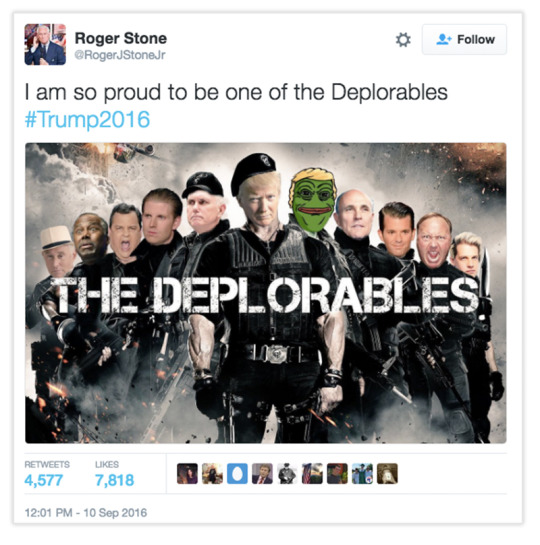
...and then Donald Trump himself....
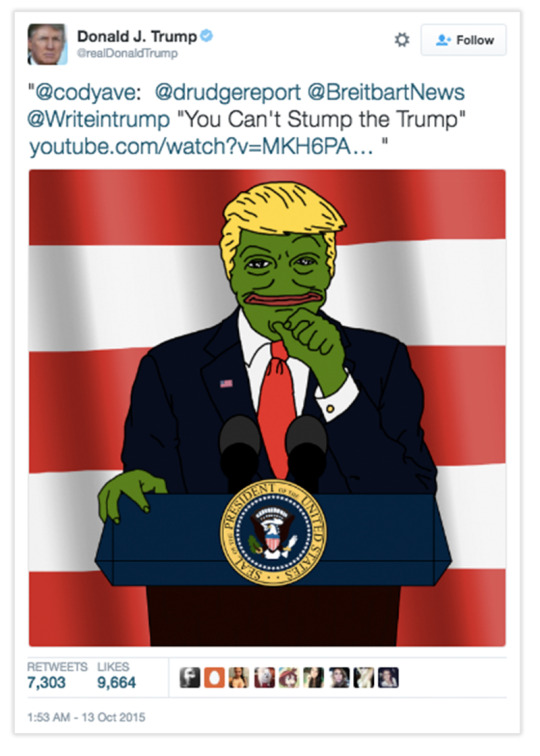
Hillary’s camp hit back, taking advantage of the fact that the wider public have no idea why Donald Trump is posting a weird green cartoon frog. So they came out with the following response:
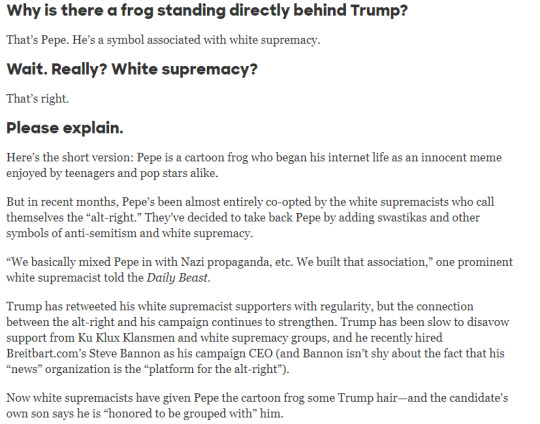
archive.fo. (2018)
This is exactly what 4chan wanted. With years and years of experience as the trolls of the internet it instantly knew that to keep the fire burning they had to spice things up:
Enter the OK symbol

Harmless? Wrong! 4chan tried to take the alt-right / white supremacy asscoiation a step further...

... and it worked!
4chan’s trolling campaigns are both reactive and proactive. The 4chan image board affords for only short lived conversations, ideas are passed down via screenshots and are often bastardised. Due to its anonymous nature and large user-base; ideas, memes & hysteria are flung about the internet with surprising results.
archive.fo. (2018). Donald Trump, Pepe the frog, and white supremacists: an explainer | H…. [online] Available at: https://archive.fo/W4Rut#selection-1045.0-1117.144 [Accessed 30 Jan. 2018].
0 notes
Text
Week 8: Crowd Wisdom, or how Reddit “solves” the Boston bombings
On April 15th, two brothers Dzhokhar and Tamerlan Tsarnaev detonated homemade bombs made from pressure cookers, killing 3 and injuring over 200 people. On April 19th the incident, the FBI released a number of photographs of the suspected bombers.

Reddit put on it’s collective detective hats and began to work out who the second suspect was. For a while Reddit worked from the material released by the FBI, but soon began to look for alternative sources. Rather than continue to use the official FBI releases, the Reddit hive-mind began to look through Flickr photos of the event for clues. Before too long any matching bags (http://www.huffingtonpost.com.au/entry/ny-post-boston-suspects-bag-men-front-page_n_3109052) began to get the journalists from news agencies riled up enough to post photos of innocent people claiming that it might just be them who is responsible for the bombings.
There was one innocent man that was unable to clear his name. Sunil Tripathi became suspect number one on /r/findbostonbombers, despite not being seen for over a month and the Tripathi family trying to find Sunil themselves (https://www.facebook.com/Help-Us-Find-Sunil-Tripathi-403275636436466/) the hive-mind went into overdrive (reddit, 2014).
After the shooting at MIT in which a police officer was killed for his gun, the name Sunil Tripathi was impossible to ignore and the police put him as a person of interest. Once he was an actual suspect, Reddit began to self congratulate and pat themselves on the back. Redditors flocked to the ‘Help Us Find Sunil Tripathi’ Facebook page and slandered the family. Asking for them to give him up. Of course Sunil was innocent, not only innocent but also dead, he had committed suicide and had not been seen for over a month.
Finally, once Sunil’s name was cleared, the subreddit deleted posts blaming him and pushed the blame on the media. The damage to the Tripathi family had already been done. The subreddit has since been deleted.
Reddit can be an excellent place for crowdwisdom, for example the subreddit /r/whatisthisthing is a community where you post a photo of something you want identified. 99% of the time you will get an answer in a short amount of time. Just don’t get reddit to solve a murder.
BI. (2018). Updates on Investigation Into Multiple Explosions in Boston. [online] Available at: https://archives.fbi.gov/archives/news/updates-on-investigation-into-multiple-explosions-in-boston/updates-on-investigation-into-multiple-explosions-in-boston [Accessed 27 Jan. 2018].
reddit. (2014). How close were we to finding the Boston Bombers? • r/misc. [online] Available at: https://www.reddit.com/r/misc/comments/1cuj7p/how_close_were_we_to_finding_the_boston_bombers/
0 notes
Text
Week 6: Fake news!
Surprising no one, the internet is becoming the sole news source for most Westerners. The internet is not like it was 10 years ago. It is more legitimate; journalists now create content only for the web rather than just re-purposing the previously more legitimate newspaper articles. It’s finally growing into itself, but shows no signs of slowing down. In October 2017 reports came out that at 55 Savushkina Street in St Petersburg something called a troll farm was busy at work manipulating the social fabric of the internet since 2011 and very likely influenced the 2017 US election as well. The troll farm spent $100,000 on pre-election Facebook advertisements (Carroll, 2018). According to the Pew Research Center, about 1 in 5 Americans receive their news from Facebook and Facebook alone (Gottfried and Shearer, 2018).
The troll farm would spend their days taking out adverts designed to cause rifts between the political parties. They would leave hundreds of comments backing Kremlin approved policy makers, (Freedomhouse.org, 2013). These trolls were tasked with confusing the digital communities they raided rather than swaying them politically. It is easier to fill a comment section with conspiracy theories and digital muck, leaving it an online trash heap. In an article by BuzzFeed : "While studying America's main media, comments that were pro-Russian in content were noticed," the author wrote. "After detailed study of the discussions they contained, it becomes obvious: the audience interprets those comments extremely negatively. Moreover, users of internet resources assume that the comments in questions were either written for ideological reasons, or paid for." (Seddon, 2014)
During the 2016 U.S. Presidential election, it was revealed that Trump retweeted a tweet from a fake account originating from one of these troll farms. @10_gop tweeted “We love you, Mr. President,” to which Trump retweeted “So nice, thank you!”. It has since been revealed that thousands of these Twitter accounts have been found and subsequently shut down. Twitter have blocked companies funded by the Kremlin such as Russia Today from advertising on the online platform (Correll, 2017). If you look at the top handle in this Whitehouse released intel (https://democrats-intelligence.house.gov/uploadedfiles/exhibit_b.pdf) you will see 10_gop is the first entry.
The extent of the the Kremlin’s manipulation is hard to gauge. 10 years, the hope to poach enough internet users to influence the US election would have been an FSB pipe-dream. In 10 years time, with the acceleration of machine learning and AI generated content, who can tell what the digital landscape will bear. "The internet has become the main threat — a sphere that isn't controlled by the Kremlin. That's why they're going after it. Its very existence as we know it is being undermined by these measures." (Seddon, 2014)
Correll, D. (2017). Trump retweeted fake account run by Russians. [online] Washington Examiner. Available at: http://www.washingtonexaminer.com/trump-retweeted-fake-account-run-by-russians/article/2639353 [Accessed 5 Feb. 2018].
Carroll, O. (2018). St Petersburg 'troll farm' had 90 dedicated staff working to influence US election campaign. [online] The Independent. Available at: http://www.independent.co.uk/news/world/europe/russia-us-election-donald-trump-st-petersburg-troll-farm-hillary-clinton-a8005276.html [Accessed 15 Jan. 2018].
Gottfried, J. and Shearer, E. (2018). News Use Across Social Media Platforms 2016. [online] Pew Research Center's Journalism Project. Available at: http://www.journalism.org/2016/05/26/news-use-across-social-media-platforms-2016/ [Accessed 15 Jan. 2018].
Seddon, M. (2014). Documents Show How Russia’s Troll Army Hit America. [online] BuzzFeed. Available at: https://www.buzzfeed.com/maxseddon/documents-show-how-russias-troll-army-hit-america?utm_term=.gnjgowBDQ#.vo4Lyz7Np [Accessed 15 Jan. 2018].
Freedomhouse.org. (2013). Russia. [online] Available at: https://freedomhouse.org/report/freedom-net/2013/russia [Accessed 15 Jan. 2018].
0 notes
Text
You’re right, the fact that these online personas are so heavily curated and removed from reality creates a really warped view of the person in question. Speaking from a place of no authority; it doesn’t surprise me that our generation (assuming you are in your early 20s) has a huge amount of depression and feelings of inadequacy. We are blurring the lines between what someone is and what someone wants us to see.
Social media has changed how society uses technology and interact with each other, but I think it also has changed how we view ourselves.
Social media affordances

Social media has changed the way we communicate and share information with one another. In the Nineteenth Century, our communication was limited to the people around us, relying heavily on face-to-face contact as the main form of communication (Siapera, 2012). Now, with the introduction of social media and social networking sites, we can communicate with an infinite number of people through a variety of different platforms and using a number of different styles.
Though the main purpose of social media has remained constant since its inception the social media platforms and networking sites used to communicate are constantly changing and growing due to their affordance. Affordance describes “what material artifacts, such as media technologies, allow people to do” (Bucher et al 2017). For example, LinkedIn is a professional social media site, launched in 2003, to connect employers to potential employees. The platform allows users to create a profile, ultimately an online resume, and build an online social network representing professional relationships. LinkedIn also allows users to research companies and view current job vacancies related to their area of expertise. LinkedIn – and other job listing websites, are replacing the need for job seekers and employees to apply for positions in more traditional methods. LinkedIn users are often head hunted by companies’ due to the experience listed on their profiles, something that would have only happened to high-profile professionals in the past.
Photo sharing sites such as Instagram and Facebook have also changed the way we communicate and interact with one another. Photo sharing sites allow you to bring your followers into your world and share in your everyday life experiences. Both of these sites allow you to share photo and video content with your followers, to hashtag posts to categorise them, to view content that you find interesting to yourself and of course to comment on other users’ photos, videos and posts. Instagram and Facebook now both have ‘stories’ which allow users to upload photos and videos that only last for 24 hours. These platforms allow users to self-curate their profiles by only showing publicly what they choose to show. Often Instagram is referred to as a ‘highlight reel’ as it isn’t necessarily a true representation of what happens in reality (Dentith, 2015).
Social media has drastically changed the way society uses technology and the way we interact and connect with one another.
Reference list
Bucher, Taina, and Anne Helmond. 2017. “The Affordances of Social Media Platforms.” In The SAGE Handbook of Social Media, edited by Jean Burgess, Thomas Poell, and Alice Marwick. London and New York: SAGE Publications Ltd.
Dentith, J 2015 Highlight reels vs reality accessed online on 10 December 2017 https://thoughtcatalog.com/jessica-dentith/2015/02/highlight-reels-vs-reality/
Siapera, E 2012, ‘Socialities and Social Media’, in Understanding New Media, Sage, London, pp. 191-208.
6 notes
·
View notes
Text
It is sad that relationships are becoming quantity over quality. We’ve been duped, there’s some sleight of hand happening in which somehow a love emoji = love. Nice post.
Empty Engagement
Social Media, in all its various shapes and forms (Facebook, Twitter, Instagram, Blogs), claims to provide a platform in which users can connect, build relationships, make new friendships and nourish old ones. However this relationship building process is not a true representation of the relationships we build in our offline lives but more so a type of virtual relationship that carries less weight and value (Centola 2010). In essence how much value can one really place on a relationship where at the end of the day you can simply unplug and carry on with your regular life.
It would seem that social media sets online relationship goals that users should strive to achieve and these benchmarks once achieve provide the user with some sense of social status or satisfaction. For example many social media platforms like Facebook and Instagram have a “friends” count, where anyone choosing to connect with or “follow” a user will form part of a connected “friendship” group (Kietzmann et. Al. 2011). Using the term friends likens these people to our friends in our everyday life, however when this number starts to reach into the hundreds is it really fair to call all of them friends, especially ones that you had never met in real life?! Nonetheless users find it rewarding to see their friends list grow, despite the lack of connection with many of them. So the value in social media friendships is placed more on the quantity rather than the quality of the relationships being developed. This is reinforced even more so by users celebrating reaching a certain number of “friends” or “followers” and by companies choosing to sponsor users with the highest followings.
Another of these relationship goals created by social media is “engagement” otherwise known as the interactions between users and their online friends or followers. Facebook, Instagram and Blogs all encourage online users to utilize comments, likes and shares as a way to interact with each other. However unlike a conversation with your friend on the telephone where you discuss your daily activities then lead into more emotional, personal and in-depth topics, online interactions often are very short, meaningless and sadly in some cases are just for self-promotion (Moon et. Al. 2016). Instead of explaining why you loved the video of your friend’s wedding so much, it seems that a like followed by a love heart emoji <3 is sufficient to express your entire thoughts and feelings. Or on Instagram for example users will like and comment on posts not for the content itself but in the hope that you might return the favour in liking their page or content.
It is sad to think that many of our relationships, instead of being nourished have in fact on analysis been reduced by social media to a daily achievement or simple acknowledgement of each other.
Centola, D 2010, The spread of behavior in an online social network experiment, Science, vol. 329, no. 5996, pp.1194-1197.
Kietzmann, JH, Hermkens, K, McCarthy, IP and Silvestre, BS 2011, Social media? Get serious! Understanding the functional building blocks of social media, Business horizons, no. 54 vol. 3, pp.241-251.
Moon, JH, Lee, E, Lee, JA, Choi, TR and Sung, Y 2016, The role of narcissism in self-promotion on Instagram, Personality and Individual Differences, vol. 101, pp.22-25.
“The Death of Friendship”
youtube
10 notes
·
View notes
Text
Comparing two platforms’ affordances
What they do and don't allow you to do with and through them
4chan's rules are very clear:
Do not upload, post, discuss, request, or link to, anything that violates local or United States law. This will be severely punished and strictly enforced.
If you are under the age of 18, or it is illegal for you to view the materials contained on this website, discontinue browsing immediately.
Do not post the following outside of /b/: Trolls, flames, racism, off-topic replies, uncalled for catchphrases, macro image replies, indecipherable text (example: "lol u tk him 2da bar|?"), anthropomorphic ("furry"), grotesque ("guro"), or loli/shota pornography.
The posting of personal information or calls to invasion is prohibited. Advertising (all forms) is also not welcome-this includes any type of referral linking.
All boards that default to the Burichan (blue) theme are to be considered "work safe". Violators may be temporarily banned and their posts removed.
The quality of posts is extremely important to this community. Contributors are encouraged to provide high-quality images and informative comments.
Submitting false reports or otherwise abusing the report system will result in a ban of indeterminate length.
Complaining about 4chan (its policies, moderation, etc.) on the imageboards can result in post deletion and banishment. The administrator will address your questions, comments, complaints, and concerns via e-mail.
Ban evasion will result in permanent bans. No exceptions-DO NOT EVADE YOUR BAN. Instead, wait and appeal it!
No excess spamming or flooding of any kind.
Impersonating the 4chan administrator, moderators, or janitors is strictly forbidden.
Remember: The use of 4chan is a privilege, not a right. The 4chan staff reserves the right to revoke access and remove content without notice
Reddit's rules are different and differ per subreddit. Anyone can create a subreddit and define the rules therein.
What’s public, what’s private
4chan's content is entirely public, the caveat being that there is a finite number of "threads" which can exist on a board (similar to a subreddit). Every time a thread is posted, a thread dies. That being said, 4chan is anonymous by default. When you post a thread/reply, the only thing used to identify you is an ID number (and even this was only recently added), before this ID number there was no way to tell that 2 posts were by the same author.
In contrast to Reddit, not all content is public, subreddits can be made private. Reddit is more "public" in that you have an online identity which you can be identified by. You can learn a lot by looking at someone's Reddit post history as it is all public.
Features they have, including interactive elements, visual, textual.
4chan has the ability to post text and photos. Some boards limit the users to text only, or certain image types. Aside from that, 4chan is quite basic.
Reddit is similar in that you only post links to content. Reddit does not host much content per say rather it aggregates and displays. Reddit is becoming more feature-rich with things such as the Reddit profile which is being beta tested as we speak.
0 notes
Text
are we connect but alone?
In response to the Ted-Ed video:
youtube
What resonated with me was Turkle's quote about self-editing (about 6:54 in) and being able to present yourself as you want to be. I think this is an important take-away as we are in a time where mental-illness among young people seems to be at an all time high. How can you hold yourself to a high esteem if you self-censor and edit your digital representation? I personally think the issue is rooted in low self-esteem and mental-illness. Is Facebook the cause, or is just a symptom?
1 note
·
View note